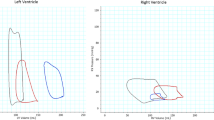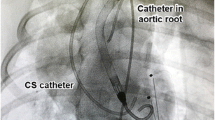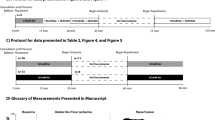Summary
We analyzed total Ca handling of the left ventricle (LV) in the mildly failing heart preparation induced by a temporary intracoronary Ca overloading intervention in eight excised and cross-circulated canine hearts. This Ca intervention consisted of interruption of coronary blood perfusion by Ca-free oxygenated Tyrode perfusion for 10min followed by high-Ca (16 mmol/l) oxygenated Tyrode perfusion for 5 min. This intervention decreased the LV contractility index,E max (end-systolic maximum elastance), by 40% after restoration of the blood cross-circulation. We expected a Ca overload or paradox failing heart resembling the postischemic stunned heart and being characterized by an increased O2 cost ofE max. However, LV O2 consumption under mechanically unloading conditions decreased by 30% from control without increasing the O2 cost ofE max. To obtain a mechanistic view of this failing heart, we investigated cardiac total Ca handling by our integrative analysis method. In this method, we obtained the internal Ca recirculation fraction (RF) from the decay beat constant of the postextrasystolic potentiation following each sporadic spontaneous extrasystole in these failing LVs. We combined the RF with the decreasedE max and the unchanged O2 cost ofE max in our recently developed formula of total Ca handling. We found that these failing LVs had a slightly but significantly increased RF accompanied by either a slightly increased futile Ca cycling or a slightly decreased Ca reactivity ofE max, or both. Any of these three possible changes can account for the unchanged O2 cost ofE max. This result indicates that the present mildly failing heart has not yet fallen into a typical Ca overload or paradox by the temporary Ca overloading intervention.
Similar content being viewed by others
References
Araki J, Takaki M, Namba T, Mori M, Suga H (1995) Ca2+-free, high-Ca2+ coronary perfusion suppresses contractility and excitation contraction coupling energy. Am J Physiol 268:H1061-H1070
Takaki M, Matsubara H, Araki J, Zhao LY, Ito H, Yasuhara S, Fujii W, Suga H (1996) Mechanoenergetics of acute failing hearts characterized by oxygen costs of mechanical energy and contractility. In: Sasayama S (ed) New horizons for failing heart syndrome. Springer, Berlin Heidelberg New York, Tokyo, pp 133–164
Hata K, Takasago T, Saeki A, Nishioka T, Goto Y (1994) Stunned myocardium after rapid correction of acidosis: increased oxygen cost of contractility and the role of Na+-H+ exchange system. Circ Res 74:794–805
Ohgoshi Y, Goto Y, Futaki S, Yaku H, Kawaguchi O, Suga H (1991) Increased oxygen cost of contractility in stunned myocardium of dog. Circ Res 69:975–988
Suga H (1990) Ventricular energetics. Physiol Rev 70:247–277
Suga H, Goto Y, Yasumura Y, Nozawa T, Futaki S, Tanaka N, Uenishi M (1988) O2 consumption of dog heart under decreased coronary perfusion and propranolol. Am J Physiol 254:H292-H303
Zhao DD, Namba T, Araki J, Ishioka K, Takaki M, Suga H (1993) Nipradilol depresses cardiac contractility and O2 consumption without decreasing coronary resistance. Acta Med Okayama 47:29–34
Namba T, Takaki M, Araki J, Ishioka K, Suga H (1994) Energetics of the negative and positive inotropism of pentobarbital sodium in the canine left ventricle. Cardiovasc Res 28:557–565
Hosogi S, Araki J, Syuu Y, Suzuki S, Mohri S, Mikane T, Matsubara H, Ohe T, Hirakawa M, Suga H (1997) Calcium equally increases internal calcium recirculation fraction before and after β-blockade in canine left ventricles. Heart Vessels 12:280–286
Syuu Y, Araki J, Lee S, Suzuki S, Mizuno J, Mohri S, Mikane T, Shimizu J, Takaki M, Suga H (1998) Effects of Ca2+ and epinephrine on Ca2+ recirculation fraction and total Ca2+ handling in canine left ventricles. Jpn J Physiol 48:123–132
Shimizu J, Takaki M, Kohno K, Araki J, Matsubara H, Suga H (1995) Sinusoidal and exponential decays of postextrasystolic transient alternans in excised bloodperfused canine hearts. Jpn J Physiol 45:837–848
Hata Y, Shimizu J, Hosogi S, Matsubara H, Araki J, Ohe T, Takaki M, Takasago T, Taylor TW, Suga H (1997) Ryanodine decreases internal Ca2+ recirculation fraction of the canine heart as studied by postextrasystolic transient alternans. Jpn J Physiol 47:521–530
Shimizu J, Araki J, Mizuno J, Lee S, Syuu, Y, Hosogi S, Mohri S, Mikane T, Takaki M, Taylor TW, Suga H (1998) A new integrative method to quantify total Ca2+ handling and futile Ca2+ cycling in failing hearts. Am J Physiol 275 (Heart Circ Physiol 44):H2325-H2333
Suga H, Sagawa K, Shoukas AA (1973) Load independence of the instantaneous pressure-volume ratio of the canine left ventricle and effects of epinephrine and heart rate on the ratio. Circ Res 32:314–322
Ohgoshi Y, Goto Y, Futaki S, Yaku H, Kawaguchi O, Suga H (1990) New method to determine oxygen cost for contractility. Jpn J Physiol 40:127–138
Araki J, Takaki M, Matsushita T, Matsubara H, Suga H (1994) Postextrasystolic transient contractile alternans in canine hearts. Heart Vessels 9:241–248
Morad M, Goldman Y (1973) Excitation-contraction coupling in heart muscle: membrane control of development of tension. Prog Biophys Mol Biol 27:257–313
Seed WA, Noble MIM, Walker JM, Miller GAH, Pidgeon J, Redwood D, Wanless R, Franz MR, Schettler M, Schaefer J (1984) Relationships between beat-to-beat interval and the strength of contraction in the healthy and diseased human heart. Circulation 70:799–805
ter Keurs HEDJ, Gao WD, Bosker H, Drake-Holland AJ, Noble MIM (1990) Characterization of decay of frequency induced potentiation and postextrasystolic potentiation. Cardiovasc Res 24:903–910
Noble MIM, Seed WA (eds) (1992) The interval-force relationship of the heart. Bowditch revisited. Cambridge University Press, Cambridge
Shimizu J, Matsubara H, Kohno K, Araki J, Takaki M, Suga H (1996) Transient mechanical alternans component always exists in postextrasystolic potentiation with and without compensatory pause (abstract). Circulation 94 (Suppl I):I-724
Wohlfart B (1982) Analysis of mechanical alternans in rabbit papillary muscle. Acta Physiol Scand 115:405–414
Yue DT, Burkhoff D, Franz MR, Hunter WC, Sagawa K (1985) Postextrasystolic potentiation of the isolated canine left ventricle: relationship to mechanical restitution. Circ Res 56:340–350
Suzuki S, Araki J, Morita T, Mohri S, Mikane T, Yamaguchi H, Sano S, Ohe T, Hirakawa M, Suga H (1998) Ventricular contractility in atrial fibrillation is predictable by mechanical restitution and potentiation. Am J Physiol 275:H1513-H1519
Tada M, Inui M, Yamada M, Kadoma M, Kuzuya T, Abe H, Kakiuchi S (1983) Effects of phospholamban phosphorylation catalyzed by adenosine 3′:5′-monophosphate-and calmodulin-dependent protein kinase on calcium transport ATPase of sarcoplasmic reticulum. J Mol Cell Cardiol 15:335–346
Bers DM (1991) Excitation-contraction coupling and cardiac contractile force. Kluwer, Dordrecht
Carafoli E (1995) Regulation of calcium signaling in cells. In: Sotelo JR, Benech JC (eds) Calcium and cellular metabolism: transport and regulation. Plenum, New York, pp 1–15
Sipido KR, Maes M, Van de Werf F (1997) Low efficiency of Ca2+ entry through the Na2+-Ca2+ exchanger as trigger for Ca2+ release from the sarcoplasmic reticulum. A comparison between L-type Ca2+ current and reverse-mode Na2+-Ca2+ exchange. Circ Res 81:1034–1044
Fabiato A (1983) Calcium-induced release of calcium from the cardiac sarcoplasmic reticulum. Am J Physiol 245:C1-C14
Solaro RJ, Wise RM, Shiner JS, Briggs FN (1974) Calcium requirements for cardiac myofibrillar activation. Circ Res 34:525–530
Hata K, Goto Y, Kawaguchi O, Takasago T, Saeki A, Nishioka T, Suga H (1994) Hypercapnic acidosis increases oxygen cost of contractility in the dog left ventricle. Am J Physiol 266:H730-H740
Takasago T, Goto Y, Kawaguchi O, Hata K, Saeki A, Nishioka T, Suga H (1993) Ryanodine wastes oxygen consumption for Ca2+ handling in the dog heart. A new pathological heart model. J Clin Invest 92:823–830
Kusuoka H, Marban E (1992) Cellular mechanism of myocardial stunning. Annu Rev Physiol 54:243–256
Hoffman PA, Miller WP, Moss RL (1993) Altered calcium sensitivity of isometric tension in myocyte-sized preparations of porcine postischemic stunned myocardium. Circ Res 72:50–56
Sato H, Hori M, Kitakaze M, Iwai K, Takashima S, Kurihara H, Inoue M, Kamada T (1993) Reperfusion after brief ischemia disrupts the microtubule network in canine hearts. Circ Res 72:361–375
Author information
Authors and Affiliations
Additional information
This study was partly supported by Grants-in-Aid for Scientific Research (09470009, 10770307, 10558136, 10877006) from the Ministry of Education, Science, Sports and Culture, a 1998 Frontier Research Grant for Cardiovascular System Dynamics from the Science and Technology Agency, all of Japan.
Rights and permissions
About this article
Cite this article
Mizuno, J., Araki, J., Iribe, G. et al. Total Ca handling in canine mild Ca overload failing heart. Heart Vessels 14, 38–51 (1999). https://doi.org/10.1007/BF02481741
Received:
Revised:
Accepted:
Issue Date:
DOI: https://doi.org/10.1007/BF02481741




